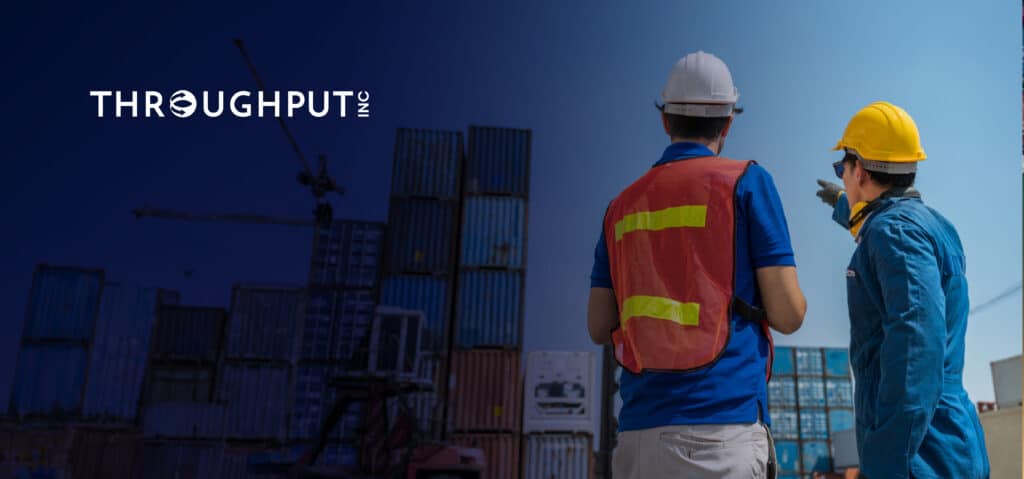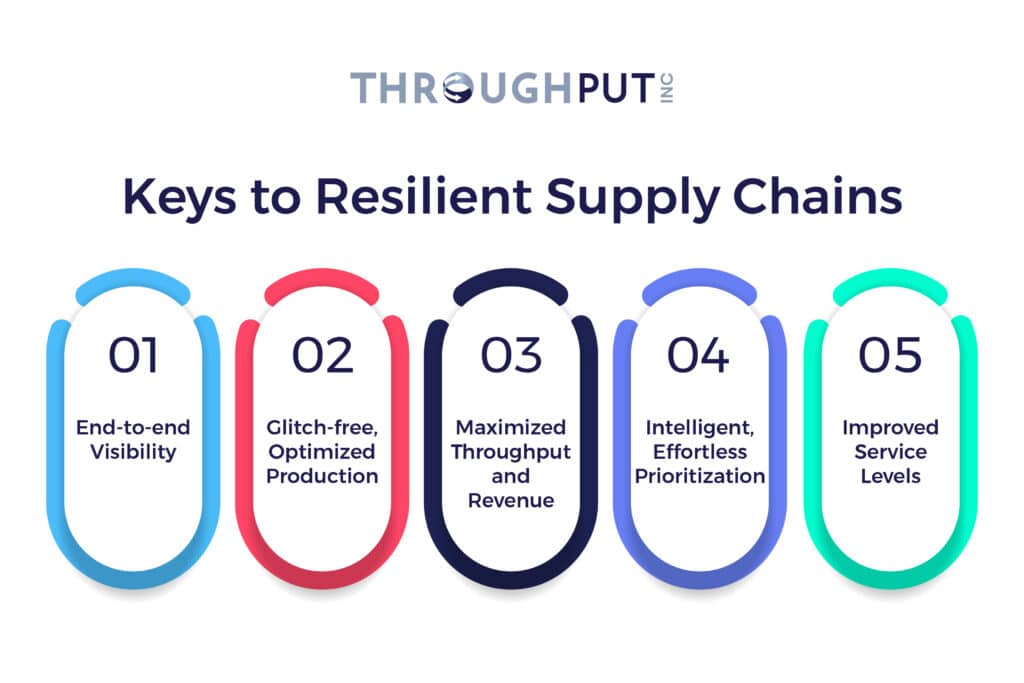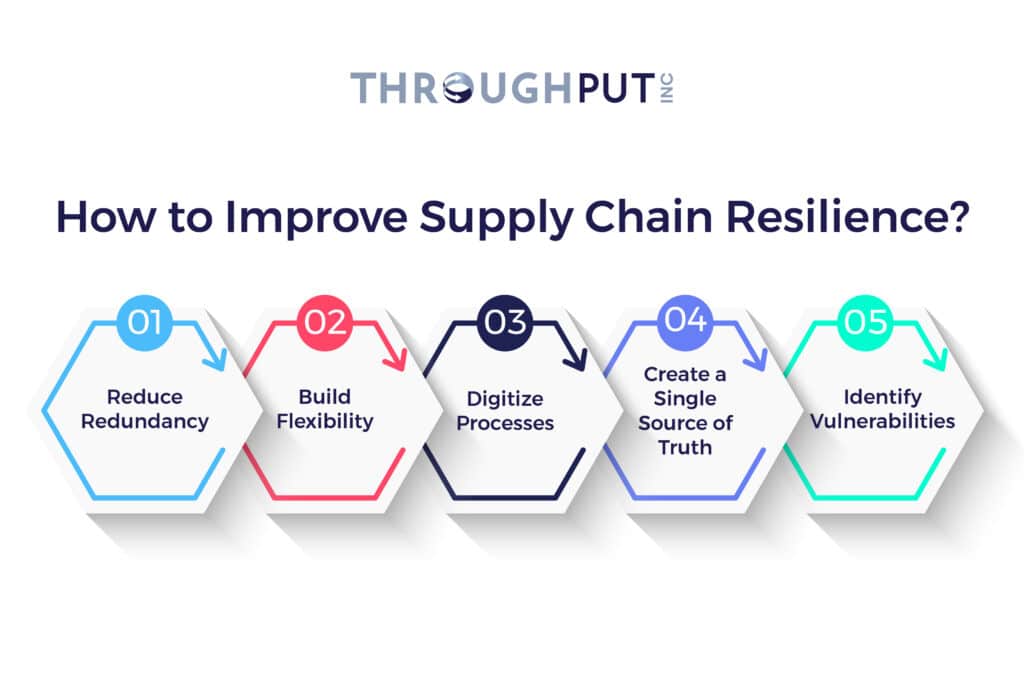Supply Chain Resilience: The Essentials And The Non-Negotiables

Supply chains across industries are now more vulnerable to failures than ever before. This isn’t the end of the problem, though!
Mounting supplier and consumer demands, rapidly climbing prices, and unexpected bottlenecks are causing reduced capacities and network changes. Natural disasters and sudden political changes worldwide add to these challenges. These vulnerabilities are devastating bottom lines and wreaking havoc on brand images, causing businesses of all sizes to hit the panic button.
Will things return to normal anytime soon (if ever)?
If not, how can businesses cope with volatility?
How can supply chains operate under multiple pressures while still working toward increasingly aggressive goals?
The answer is what we already know – we need to do more with less.
Supply chains now need to be nimbler, more frugal, and more resilient than ever before to ensure a continued flow of goods and services and maximized revenue.
Adaptability is vital as companies need to respond to uncertainties in an increasingly volatile market, and better yet, predict and be prepared for them ahead of time.
Establishing a seamless supply chain is mission-critical for most businesses. Simply put, a sophisticated, proactive, agile, and efficient supply chain is no longer just an option – it’s a basic need.
Businesses can no longer push the market. They need to respond to it.
Today’s market forces are more dynamic than ever before. This means that the traditional business model just doesn’t cut it anymore. Businesses can no longer afford to function based on a linear “push” model – where they procure raw materials, produce goods, and go to market with what they have, whenever they have it.
Nowadays, customer demand witnesses significant shifts even while businesses go about their daily operations.
In other words, the demand that exists at the time of procurement may be nothing like the demand at the time of production, which may in turn be vastly different from demand at the time of distribution. Thus, there is a critical need for proactive, intelligent, demand-based planning at every stage of the entire supply chain – because failure is just not an option anymore!
Supply chain resilience is the only long-term solution to ensure survival. The best way to achieve that is to automate flow across your supply chain, from end to end, so that efficiency and optimization become the bedrock of your business.

What is Supply Chain Resilience?
A resilient supply chain is a smarter supply chain that has learned to adapt itself to continuous disruptions. These supply chains are those that can scale to meet new demands as and when the customer needs change.
They are more reliable, tune in well to volatilities and help build the necessary trust between the manufacturer and the final customer. A resilient supply chain has great visibility and the agility to shift sourcing, manufacturing and distribution activities around fairly rapidly.
A recent study by Gartner suggests that only 21% of manufacturers believe that they have a highly resilient network.
As the manufacturing world goes through several tides of changes owing to the ripple effect of the global pandemic, it is imperative that companies balance supply chain resilience and efficiency to secure their networks.
While most supply chain leaders recognize that becoming more resilient is the need of the hour, existing challenges such as alternative factories, manual processes and the lack of adequate real-time data to drive decisions, can prevent the creation of lean supply chains and resilience.
The rebalancing of supply chain efficiency and resiliency here is not an easy task. Most of the time, increased resilience comes with additional costs and additional resources which may be difficult to achieve.
Having said this, despite being fragmented, supply chains can become resilient over a period of time.
By focusing on the fundamentals such as people, processes, and technology, manufacturers can steer their way through disruptions and build a more resilient, longer-term digital operations strategy along the way.
What Are the Benefits of Supply Chain Resilience?
Supply chain resilience has multiple benefits in the current volatile times where geopolitical uncertainties, natural disasters, and economic crises are rife.
- You can predict demand ahead of time and work backward along the supply chain to ensure adequate capacity provisioning for demand fulfillment.
- You can increase efficiency across the entire length of the supply chain (by optimizing orders, routes, and lead times).
- You can minimize costs across the supply chain (procurement, production, and distribution).
- You can leverage opportunities to optimize supply chain flow (prioritize orders and focus on the ones that generate more revenue).
- You can identify and proactively fix bottlenecks in the supply chain in real time (before throughput is affected).
- You can vastly improve services (in terms of accessibility, availability, and on-time delivery).
- You can make intelligent make/buy/wait decisions (for procuring materials).
Keys to Resilient Supply Chains
Demand-driven and real-time-adaptability of supply chains not only helps optimize cost and effort but also builds immense resilience into your entire supply chain to safeguard your business against real-time as well as future developments. So what are the key characteristics of resilient supply chains?

- End-to-End Visibility
Resilient supply chains provide you the power to track SKUs in real time – from supplier to plant to store – via easy-to-understand graphs. Thus, you can view the aggregate volume received, delivered, and sold by route and shipment type.
- Glitch-free, Optimized Production
In a resilient supply chain, rapid detection and resolution of bottlenecks, along with proactive, predictive demand-based planning and real-time adaptation to ongoing changes in influencing factors, optimize production and operations.
- Maximized Throughput and Revenue
By acquiring the ability to proactively identify and leverage innovative savings opportunities at scale, and to measure and analyze the value, cost, and benefit impact of various scenarios, a resilient supply chain maximizes throughput and revenue.
- Intelligent, Effortless Prioritization
In a resilient supply chain, where decisions are simplified and driven by real-time data, prioritizing resources and efforts becomes straightforward. More importantly, the capability to adapt responsively to volatile market and production conditions enhances supply chain resilience and fosters strong business growth.
- Improved Service Levels
By optimizing and validating multiple runtime scenarios, a resilient supply chain enables you to select those that deliver maximum value, thereby enhancing service levels. With the capability to test the impact of new ideas on operations, you gain the freedom to focus on approaches that yield the best outcomes—minimizing costs and impact on the business.
How to Improve Supply Chain Resilience?
You can improve supply chain resilience by reducing redundancy, building flexibility, adopting digitized processes, identifying vulnerabilities and creating a single source of truth.

Reduce Redundancy
A resilient supply chain is built on the premise that redundancy is acceptable, but only to a certain limit. Resilient networks can be built by creating redundancies to an acceptable extent, throughout the supply chain.
The manufacturer can always stock extra inventory, maintain low capacity utilization, and have multiple suppliers.
Although redundancy can provide some breathing room to continue operating after a disruption, usually it is a temporary and very expensive measure to have. Most manufacturers have to pay for redundant stock, capacity, and workers.
Moreover, such excess capacity is likely to result in inefficient operations, low quality, and significant cost increases. This restricts the organization from creating agile and resilient supply chains.
Build Flexibility
Building flexibility is another way to create supply chain resilience. With increased supply chain flexibility, manufacturers are able to withstand significant disruptions and are in a better position to respond to demand fluctuations.
Having standardized processes, manufacturers can easily move production among plants using interchangeable and generic parts in many products.
Similarly, using simultaneous rather than sequential processes across product development and distribution can speed up the recovery and benefits of improved market responses.
Finally, it is important to align the procurement strategy with supplier relationships to create deep and strong relationships with the supplier network.
3. Digitize processes
One of the easiest ways to achieve resilience across supply networks is to digitize as many operational processes as possible.
However, due to the complexities involved in overhauling a vast network of global paper-based processes and siloed operations, many organizations avoid digitizing the entire supply chain.
On the other hand, those companies that take the leap of faith and implement digital supply chain practices, do see immediate and long-term benefits.
Digitizing operations can easily unlock vast records of real-time valuable data that manufacturers can use to make decisions about production and critical capabilities in today’s crisis.
Create a Single Source of Truth
From a technology perspective, creating a centralized incident management system can help systematically capture issues, with clear accountability and supply chain context.
Having a single source of truth can enable faster problem-solving and also ensure that all key stakeholders are involved in the decision-making process.
Most importantly, it is also equally equipped with the latest updates. After all, decisions are only as good as the data that guides them, and having fragmented sources of this data doesn’t help.
Identify Vulnerabilities
For a resilient supply chain, you need to identify vulnerabilities. Most supply chain vulnerabilities manifest in areas such as planning and supplier networks, transportation and logistics systems, financial resiliency, product complexity, and organizational maturity.
A good understanding of the supply chain risk considers these underlying vulnerabilities in the supply chain that can make it fragile. It also looks into the level of exposure or susceptibility to unforeseen events that can exploit these vulnerabilities.
Therefore, a healthy supply chain risk assessment can eliminate vulnerabilities and help seed the much-needed resilience.
The Role of AI in Developing Resilient Supply Chains
Artificial Intelligence, given its capacity to process large amounts of data at speed, improves the responsiveness of supply chains, a crucial sign of resilience. Here are the various use cases of AI in building supply chain resilience.
AI for Predicting and Responding to Demand Fluctuations
AI-powered tools work with vast datasets and interpret market trends offering insights in real-time for timely responses, which in turn, enhances your operational agility, optimizes inventory management and ensures customer demands are met efficiently.
For instance, Throughput AI’s demand sensing capabilities have helped agribusinesses in predicting near-term and short-term demands which was a critical turning point for its range of perishable goods.
These businesses could also mitigate risks by leveraging weather-related demand fluctuations and seasonality.
With Throughput, the company could optimize stock and market responsiveness, effectively addressing core issues related to overproduction or shortage.
Eventually, they could increase their short-term forecasting accuracy by 40%.
The company could minimize excess stock, optimize production capacity, and achieve the 5 R’s – Right stock, Right quantity, Right cost, Right time, and Right location.
AI for Intelligent and More Accurate Decision-Making
Supply chain resilience is characterized by the agility that comes from quick decision-making.
With so many decisions to make on a day-to-day basis, relying on your gut or experience may just not be enough.
You have the data that can get you some incredible insights. And an AI-powered tool can ensure you have access to those insights in real-time.
Throughput also goes a step further.
As a Gartner-recognized supply chain intelligence tool, ThroughPut supports real-time insights with actionable recommendations.
Providing insights alone meant the onus of making a million decisions still lay on individuals. ThroughPut has solved this problem for the supply chain community.
AI for Analyzing “What If” Scenarios
‘What Ifs’ are common these days; marketplaces are full of such scenarios.
Businesses have a tough time grasping these uncertainties.
Artificial Intelligence can make a difference here because it can generate, assess, and analyze thousands of permutations and combinations.
Take the case of the recent issues at the Suez and Panama Canals. In both cases, AI is providing crucial answers to businesses on whether it is prudent to wait till the blockage clears out or should they consider alternative routes, or consider air transport.
AI gives the clearest picture but most of all, it devises swift responses that allow organizations to prioritize shipments, and optimize transportation modes and routes to minimize delays.
AI for Maximizing Capacity Utilization
Capacity utilization is one thing but maximizing it is a different ballgame altogether.
How can you know if your current capacity can handle the forecasted demand?
AI-powered tools offer you insights into capacity maximization by analyzing data and trends so that you can make informed decisions and avoid unnecessary investments in adding capacity, which could have turned into a big loss for the business.
There’s the other side to the story too!
AI not only helps businesses avoid overinvesting in capacity utilization but also ensures that the available capacities are not under-utilized. This is done with an accurate demand forecast and an understanding of capacity constraints.
Supply Chain Resilience: The Best Bet To Tide Over Tough Times
In today’s volatile market conditions, supply chain resilience cannot be compromised. That’s true!
But can a traditional resilience software system give the right results suited for this dynamic landscape?
No.
You need an equally dynamic tool powered by Artificial Intelligence and advanced analytics power.
That’s how your supply chain planning will stay agile to navigate the disruptive forces while ensuring that your operations stay proactive and optimized.
If you are looking at sustained business success, you need to book a demo call with us today.
